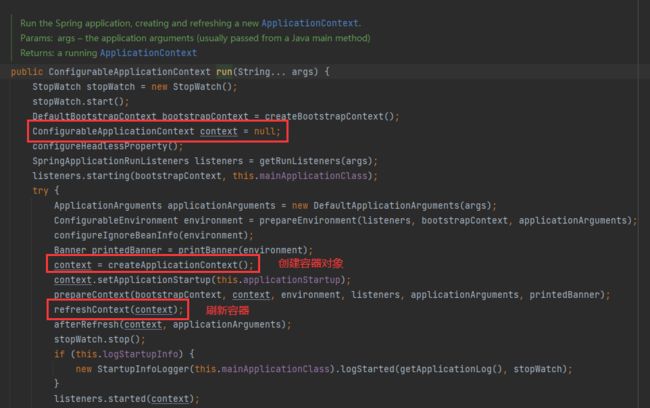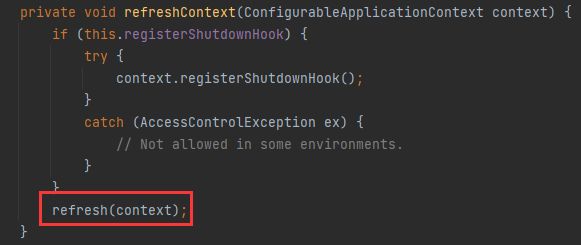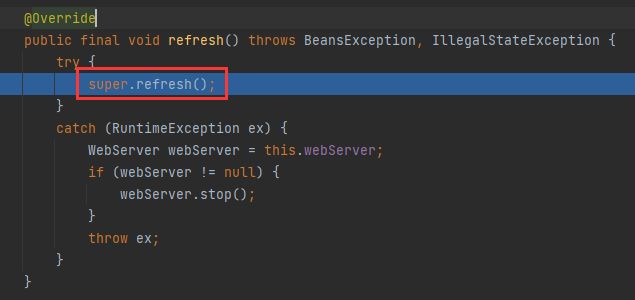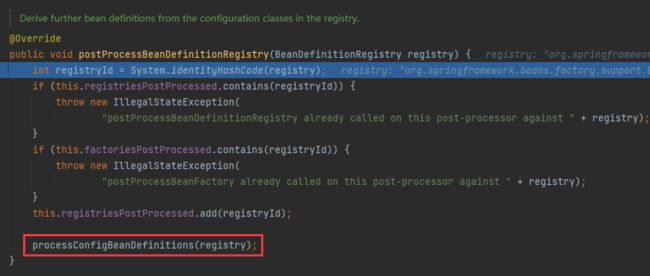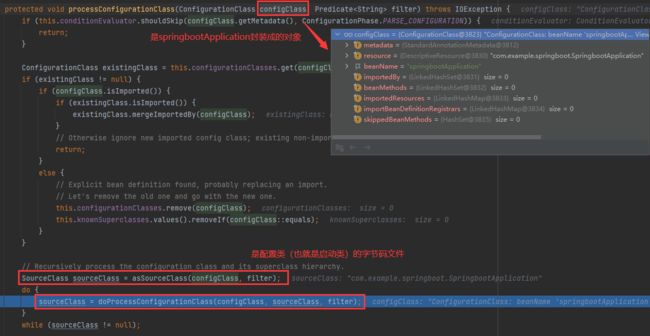【Spring源码】SpringBoot默认组件扫描
前言
在项目中我们创建了Controller,这个Controller是如何被spring自动加载的呢?为什么Controller必须放在启动类的同级目录下呢?
文章目录
- 一、前期准备
-
- 1.1 创建工程
- 1.2 创建Controller
- 二、探究过程
-
- 2.1 探究目标
- 2.2 探究过程
-
- 2.2.1 回顾容器bean的创建与刷新
- 2.2.2 SpringApplication
- 2.2.3 ServletWebServerApplicationContext
- 2.2.4 AbstractApplicationContext
- 2.2.5 PostProcessorRegistrationDelegate
- 2.2.6 ConfigurationClassPostProcessor
- 2.2.7 ConfigurationClassParser
- 2.2.8 ComponentScanAnnotationParser
- 2.3 结论
- 参考视频:https://www.bilibili.com/video/BV1Bq4y1Q7GZ?p=6
- 通过视频的学习和自身的理解整理出的笔记。
一、前期准备
1.1 创建工程
创建springboot项目,springboot版本为2.5.0,引入spring-boot-starter-web依赖,pom文件如下:
<project xmlns="http://maven.apache.org/POM/4.0.0" xmlns:xsi="http://www.w3.org/2001/XMLSchema-instance"
xsi:schemaLocation="http://maven.apache.org/POM/4.0.0 https://maven.apache.org/xsd/maven-4.0.0.xsd">
<modelVersion>4.0.0modelVersion>
<parent>
<groupId>org.springframework.bootgroupId>
<artifactId>spring-boot-starter-parentartifactId>
<version>2.5.0version>
<relativePath/>
parent>
<groupId>com.examplegroupId>
<artifactId>springbootartifactId>
<version>0.0.1-SNAPSHOTversion>
<name>springbootname>
<description>Demo project for Spring Bootdescription>
<properties>
<java.version>1.8java.version>
properties>
<dependencies>
<dependency>
<groupId>org.springframework.bootgroupId>
<artifactId>spring-boot-starterartifactId>
dependency>
<dependency>
<groupId>org.springframework.bootgroupId>
<artifactId>spring-boot-starter-webartifactId>
dependency>
<dependency>
<groupId>org.springframework.bootgroupId>
<artifactId>spring-boot-starter-testartifactId>
<scope>testscope>
dependency>
dependencies>
<build>
<plugins>
<plugin>
<groupId>org.springframework.bootgroupId>
<artifactId>spring-boot-maven-pluginartifactId>
plugin>
plugins>
build>
project>
1.2 创建Controller
创建一个简单的Controller用于测试
@RestController
public class HelloController {
public void helloController() {
System.out.println("创建了");
}
@RequestMapping("hello")
public String hello() {
return "hello";
}
}
二、探究过程
2.1 探究目标
在项目中我们创建了Controller,这个Controller是如何被spring自动加载的呢?为什么Controller必须放在启动类的同级目录下呢?
如果我们想要加载不在启动类同级目录下的bean对象,需要在启动类中使用
@ComponentScan注解。
目标:SpringBoot项目中我们没有设置组件扫描的包,为什么它会默认扫描启动类目录下所有的包。
2.2 探究过程
2.2.1 回顾容器bean的创建与刷新
在SpringApplication的run()方法中,创建了spring容器context,并通过refreshContext(context)更新容器加载我们自定义的bean对象。
我们发现在执行完refreshContext(context)代码后,自定义的bean对象(HelloController)就已经被创建了,说明refreshContext(context)过程中创建了自定义bean对象。
下面我们看看究竟是refreshContext(context)中哪些方法创建了自定义bean对象。
2.2.2 SpringApplication
我接着看refreshContext(context)方法
refreshContext()方法
2.2.3 ServletWebServerApplicationContext
再调用父类的refresh()方法
2.2.4 AbstractApplicationContext
refresh()方法
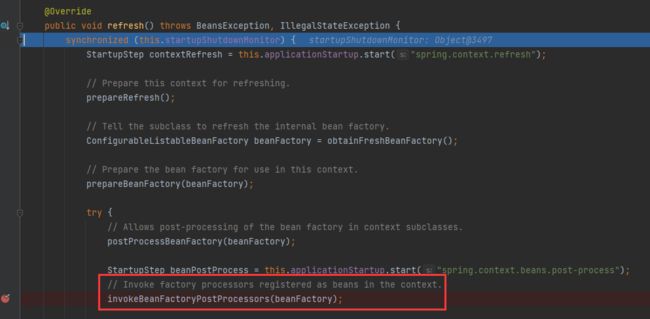
在执行完这行代码后创建了自定义bean的beanDefination对象。下面来看看这行代码。
invokeBeanFactoryPostProcessors()方法
根据这个名字可以看出来是调用了bean工厂的后置处理器。
2.2.5 PostProcessorRegistrationDelegate
invokeBeanFactoryPostProcessors()方法
调用bean工厂的后置处理器,这个方法很长,最终找到了是这行代码,调用BeanDefinition注册的后置处理。

invokeBeanDefinitionRegistryPostProcessors()方法
拿到后置处理器,调用后置处理器的BeanDefinition注册。
2.2.6 ConfigurationClassPostProcessor
postProcessBeanDefinitionRegistry()方法
processConfigBeanDefinitions()方法
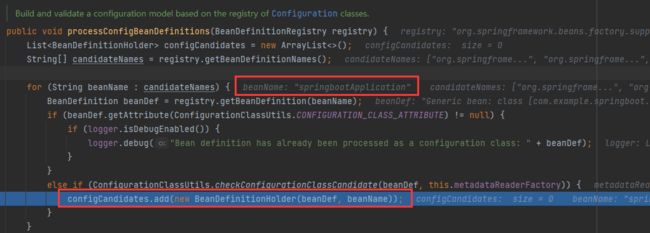
把启动类的beanDefinition对象添加到了configCandidates集合中,后面将要用到。
这个parser是配置类的处理器,通过传入很多参数构造了这个parser处理器。

parser.parse(candidates)中,把启动类对应的beanDefinitionHolder对象传进去了。
下面看看这个parse方法。
parse()方法
2.2.7 ConfigurationClassParser
parse()方法
processConfigurationClass()方法
doProcessConfigurationClass()方法
if (configClass.getMetadata().isAnnotated(Component.class.getName())) { ... }
判断启动类上是否加上了@Component注解,这里的if条件成立。
因为@SpringBootApplication包含@SpringBootConfiguration,@SpringBootConfiguration包含@Configuration,@Configuration包含@Component,所以加上了@SpringBootApplication注解就相当于加上了@Component注解。
processMemberClasses()方法
里面有很多处理各类注解的方法
// Process any @PropertySource annotations
// Process any @ComponentScan annotations
// Process any @Import annotations
// Process any @ImportResource annotations
// Process individual @Bean methods
后续将要对这个集合进行扫描,那么看看它是如何扫描的。
2.2.8 ComponentScanAnnotationParser
parse()方法
ClassUtils.getPackageName(declaringClass):获取启动类所在的包,根据传入类的全类名获取包名。
scanner.doScan(StringUtils.toStringArray(basePackages)):扫描启动类所在的包
2.3 结论
在容器刷新时会调用BeanFactoryPostProcessor(Bean工厂后置处理器)进行处理。其中就有一个ConfigurationClassPostProcessor(配置类处理器)。在这个处理器中使用ConfigurationClassParser(配置类解析器)的parse方法去解析处理我们的配置类,其中就有对ComponentScan注解的解析处理。会去使用ComponentScanAnnotationParser的parse方法去解析。解析时如果发现没有配置basePackage,它会去获取我们加载了注解的这个类所在的包,作为我们的basepackage进行组件扫描。
